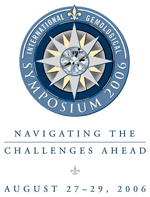Fourth International GIA Symposium Report
October 09, 06
 |
By Danielle Max
With an opening keynote speech from former U.S. Secretary of State Madeline K. Albright, and a 75th birthday party featuring a concert by Chris Isaak, the Fourth International Symposium, held at the Manchester Grand Hyatt in San Diego, kicked off in style.
With her well known love of jewelry – especially brooches – Albright proved an extremely popular opening speaker choice. Her comment, “I am delighted to be here for the simple reason, I love jewelry,” was met with rapturous applause. Playing to the audience, Albright revealed that she has no sins, except for buying jewelry. “I am grateful to the GIA for showing me it’s not a sin but a sign of excellent character,” she joked.
Though her speech, and the question and answer session hosted by GIA Acting President Donna Baker that followed, dealt mainly with U.S. politics, Albright told the gathering how she had used her brooches as a diplomatic tool when she was secretary of state. President George Bush famously told delegates at the 1988 Republican National Convention to “read my lips,” Dr. Albright, however, had a “read my pins” policy. After Sadaam Hussein called her a snake, Albright would wear a snake brooch whenever she met with Iraqi officials. Following the arrest of Hussein, Albright bought a brooch depicting a snake skewed with a dagger, which she wore to the Symposium.
| |
Following Albright’s speech, Nir Livnat, CEO of the Steinmetz Group, the premier sponsor of the Symposium, presented Albright with a diamond encrusted sun-shaped brooch. Upon receiving the gift, Albright quipped, “This is much better than the dentists’ symposium.”
Albright also attended the GIA’s 75th anniversary party, held at the Robert Mouawad campus in Carlsbad. While the private concert by Chris Isaak was undoubtedly a highlight of the event, so too was a special museum exhibit, “Celebrating Excellence in Gems and Jewelry,” which was packed throughout the night. The pieces on display included the Hooker Emerald Brooch and the Bismarck Sapphire Necklace - on loan from the Smithsonian, a 1908 “kokosh- nik” tiara courtesy of Cartier, and a fancy-colored diamond floral brooch by Bulgari, on loan from the Royal Ontario Museum.
The first full day of the 2006 International Symposium began with a breakfast speech by behavioral market research expert
Paco Underhill. Underhill, the founder, CEO, and president of Envirosell Inc., an international behavioral market research and consulting company, spoke about the consumer of the 21st century, and the need for change in the retail side of the jewelry industry. 
During the course of his well attended speech, Underhill was especially tough on retailers who complain that the Internet is destroying their business. “The net is failing you because you haven’t figured out a way to use it,” he said in no uncertain terms. “If you don’t use the Internet in 2006, goodbye, because you won’t be here in 2010.”
However, it was not all bad news from the man who has made a career out of telling some of the world’s top retailers how they can improve their businesses. Underhill advised the audience – which included many retailers – that they must figure out how to fit into their customers’ lives. As an example, he cited the Damas chain in the Middle East, which offers party rooms for weddings and birthday parties in which groups of women can try on jewelry in a relaxed and accessible atmosphere. “Customers have changed,” he said, “and now it is the jewelry store that needs to be refreshed.”
As Underhill’s words still echoed throughout the hall, the extensive Symposium program proper began. The day was divided into hour and a half long discussion, on topics including Diamonds: Mapping the Future, Jewelry: The Changing Landscape, Luxury Retailing: Going for the Bling, and Identification Technology: The CSI Factor, all of which were standing room only. While all the sessions contained a question and answer session, it was during the debate centers that Symposium attendees really had the chance to air their opinions.
On the first day, the three debates focused on ‘hot’ topics in the industry: The Great Synthetic Diamond Debate, Ethical Dilemmas in the Jewelry Industry, and Locality of Origin: Does it Really Matter? With the care for details that the GIA showed throughout, the Symposium, organizers injected some fun into the proceedings, with debates held in rooms decked out to resemble a jungle and a boxing ring, while the synthetic diamond debate was held in a Roman amphitheatre themed room, complete with stone pillars, an ancient Roman backdrop, and a gong to prevent speakers overstepping their allotted talking time. Even the lighthearted atmosphere, however, could not detract from the divisiveness that synthetic diamonds are currently causing throughout the diamond industry.
| |
Key among the discussion points was the fundamental issue of the nomenclature of synthetic diamonds. Even among the synthetic diamond producers represented on the panel – Tom Chatham of Chatham Created Gems and Diamonds, Bryant Linares of Apollo, and S. Clark McEwen of Gemesis, there was disagreement about what to call synthetic diamonds. Options ranged from synthetic, synthetic diamonds (which former WFDB President Shmuel Schnitzer, who alone on the panel represented the ‘natural’ diamond industry, told the audience was already a compromise from what many in the natural diamond trade wanted to refer to simply as synthetics), cultured diamonds, man-made diamonds, or lab grown diamonds, with many in the audience concerned that calling them synthetic or cultured will lead to confusion among consumers.
The discussion also focused upon the need, or otherwise, of gem lab reports for synthetic diamonds. Though the GIA recently announced that they were postponing the launch of synthetic diamond gem reports, Dr. James Shigley, the director of research at the GIA confirmed that the Institute is still intending to produce the certificates, though there has been no decision on the final wording to appear on the reports.
As the synthetic diamond debate drew to a close, without any real closure, it was obvious that chief among the audience’s concerns was the subject of consumer confidence; an issue that dominated many of the discussions on the first day of the Symposium, and a theme that characterized the conference as a whole.
Following a ‘sunset soiree’ sponsored by Dimexon Eurostar and Hearts On Fire, on the second evening of Symposium, and a breakfast speech given by Frank Abagnale, one of the world’s most famous conmen (not least of all owing to the movie Catch Me If You Can, which, ironically, stars Lenoardo DiCaprio – star of The Blood Diamond) the final day of Symposium was also jammed with discussion. Topics included, The Changing Tides in Distribution Channels, Business Perspectives: Charting the Globe, Gemstone Treatments: Friend or Foe, and The Great Internet Debate: Ride the Wave or Wipe Out.
In a panel dedicated solely to the subject of consumer confidence and trust, IDMA President Jeffrey Fischer took up the synthetic diamond debate with his comments that the key to dealing with synthetics was detection, disclosure, and differentiation. “The trade must do its share in backing up the labs,” he said as he acknowledged that synthetic diamond producers have the right to compete for consumer attention – a view that, if the previous day’s debate was anything to go by, not everybody in the industry shares.
Esther Fortunoff Greene told the audience that retailers are the “final frontier” in the trust stakes. Fortunoff Greene, who oversees the buying, manufacturing, and quality control departments at the fine jewelry retail chain Fortunoff, commented, “Consumers have to trust us to just walk in the door…If we continue to care about [the] bigger issues, we will manage together to become a more ethical trade.”
Speaking on behalf of the DTC, Sally Morrison touched on the issue of The Blood Diamond
movie, which is set for release during the all important holiday season. “The movie does threaten our industry collectively,” said Morrison. “It will have a huge impact beyond those who go to the mall to see it.” The role of the trade, she urged, was to prevent any misunderstanding about conflict diamonds. “The whole key to crisis management is anticipation. The media abhor a vacuum,” she said in connection with the seriousness that the movie is being taken by the DTC, and other organizations. Morrison also urged participants not to let inaccuracies stand unchallenged. Facts do not speak for themselves, she said, as she warned that the industry should not assume that moviegoers (and consumers) will know the proper facts about conflict diamonds and the Kimberley Process.
Perhaps the most surprising comments about consumer confidence, however, came during Maurice Tempelsman’s closing keynote speech in which he mentioned the grading lab scandal that hit GIA last year; a subject that was glossed over during the Symposium. “Every one of us knows that there is no institution, whether public or private, whether good or even great, that can deem itself forever immune from such troubles,” said the Lazare Kaplan International chairman. “Human nature remains, and will ever remain, human nature, as will human frailty. And we all know, too, that the best way to deal with these problems when they arise is as directly, as forcefully and – to the extent one is, like the GIA, a public institution – as openly as possible.”
He continued, “While I would never presume to speak for a body such as the GIA, it seems to me that in this case the question is: who does the GIA exist to serve – the public, or the industry? Like most such questions, this one grossly oversimplifies by implying that the public and the industry somehow sit at opposite poles, which clearly they do not. And in the ordinary course the simple answer that the GIA could and should provide is both.”
The importance of trust and consumer confidence, was clearly summed up by Tempelsman who said, “We dare not in this industry risk, much less forfeit, consumer confidence in the integrity of our product or we will have no industry.”

